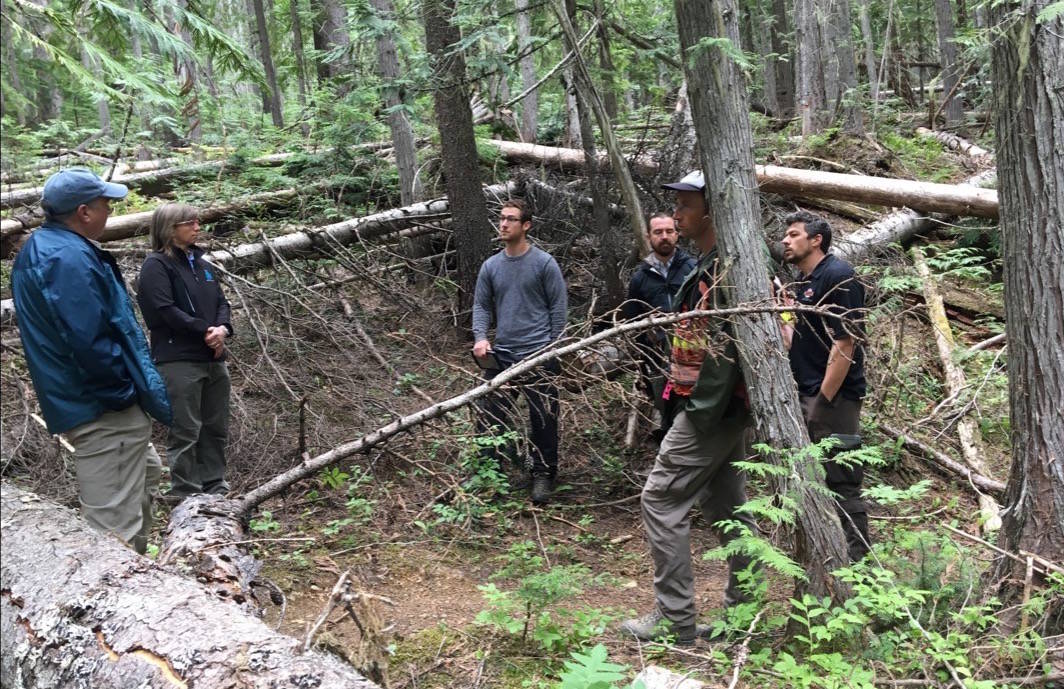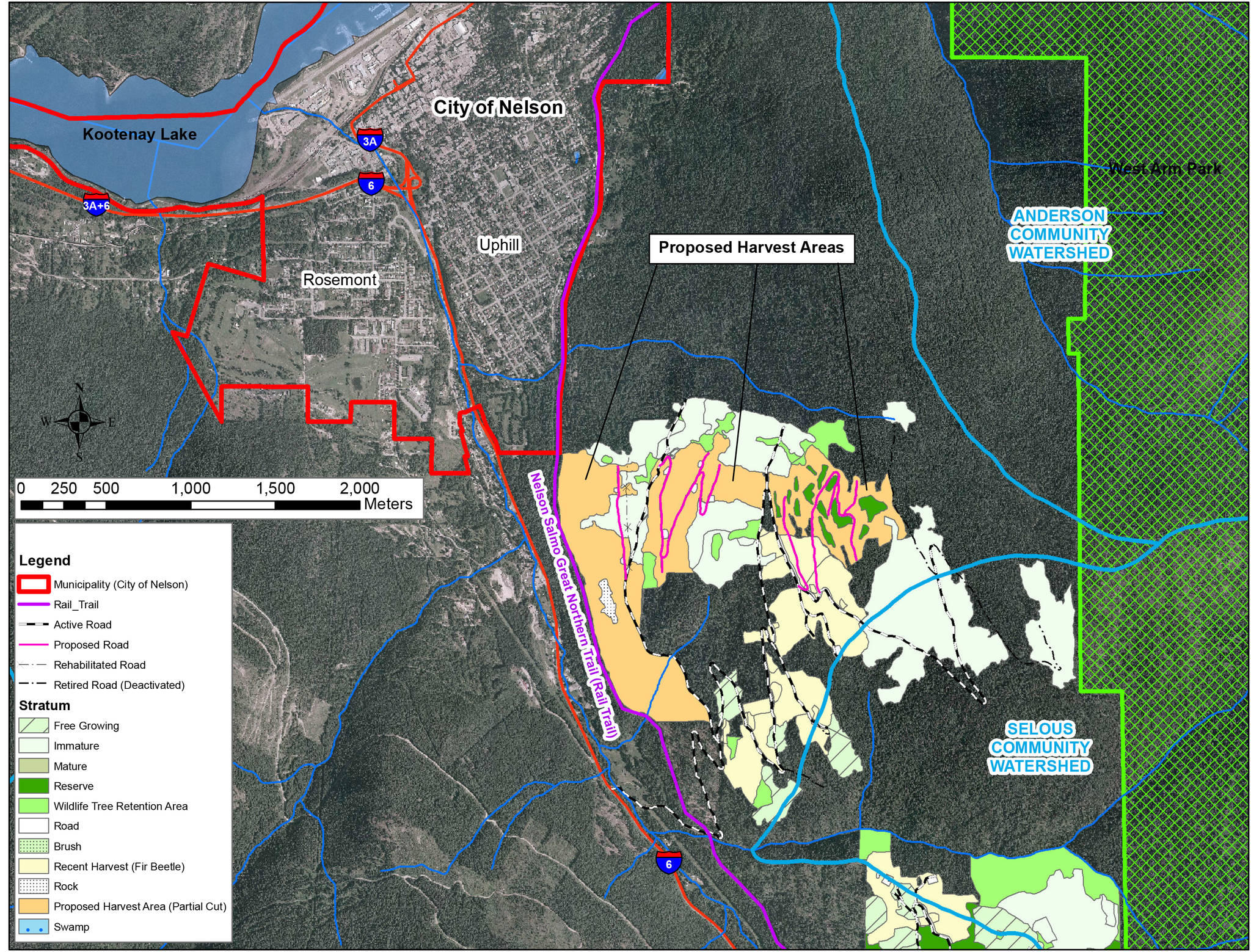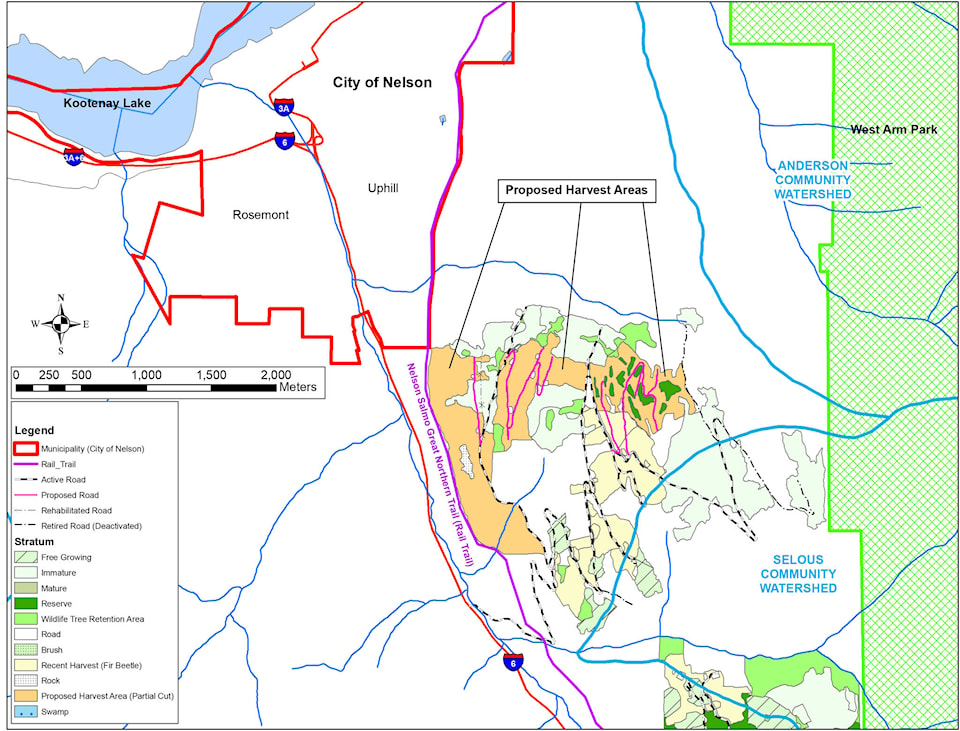A West Kootenay logging company is collaborating with local governments in an unusual effort that attempts to combine logging and wildfire protection.
When Kalesnikoff Lumber Co. Ltd. logs 150 hectares in the Selous Creek drainage near Nelson starting this fall, they’ll log more selectively than they otherwise would have. They will leave certain species they would otherwise have cut. The result will not look like a clearcut and it will be more fire resistant.
“What we are doing here is ground breaking,” says John Cathro, a forest consultant working on the project.
The groundbreaking part is the partnership. The company has collaborated on the logging plan with the Regional District of Central Kootenay (RDCK), the City of Nelson and the B.C. Wildfire Service.
The work will take place very close to Nelson, including a stretch adjacent to the Rail Trail at the Nelson cemetery that will extend about two kilometres along the trail in the Salmo direction.
Protecting Nelson’s water supply
The Selous Creek drainage, just south of Nelson and visible from many parts of the city, has been identified by the RDCK as one of the most serious fire threats in the region. This is because the forest there contains an intense build-up of dry flammable fuel, it’s close to human habitation, and it is very near one of Nelson’s secondary drinking water intakes.
So the RDCK and the city have had the Selous Creek forests on their radar for some time, but they have very little power over the timber there. Kalesnikoff, because of its timber license, has the right to decide whether, when, and how the area is logged.
But the wildfire threat has made collaboration essential. The city and the RDCK have entered into a partnership with the company to change the way the area will be logged. The goal of their joint plan is to provide fire protection as well as a viable timber harvest.
Unconventional logging practices
This means that conventional logging practices will be governed by wildfire mitigation techniques such as removing the small diameter trees, removing the surface fuel (underbrush, deadfall and low-hanging limbs), and leaving the fire resistant trees.
The company will be cutting different tree species than they otherwise would.
“We are selecting the opposite species mix of what our mill would normally want,” says Gerald Cordeiro, a forest development manager at Kalesnikoff Lumber.
“Normally our mill would like to take Douglas fir, but Douglas fir is fire resistant and drought resistant and designed for shade and it is climate change resilient. So we are leaving trees we would normally want to put in our mill.”
They will also be leaving larch and making sure deciduous trees are left standing. Both are relatively fire resistant. They will log more flammable species like lodgepole pine, hemlock, balsam, spruce and cedar.
The number and type of trees being retained will vary across the landscape depending on the forest mix and the terrain.
“We will be harvesting with much more finesse, sometimes a single tree selection approach,” Cordeiro says, “which makes the harvest cost higher and more difficult to achieve. So we are riding a fine line of financial feasibility.”
Decisions made in collaboration
The RDCK has received a grant of $548,000 from the Forest Enhancement Society of B.C. to do this work but none of that goes to Kalesnikoff. It will be used by the RDCK for things such as post-harvest clean up of surface fuels, pruning of residual trees, thinning reserve patches and hauling small diameter low value material to a mill.
Another change for Kalesnikoff is that the decisions about what to cut and what to leave are being made not just by the company but by a collaborative group.
“We all go out to the bush together,” Cordeiro says, “and walk around, and you get a bunch of heads together, and one person says we should do this, and another person says yeah but what about this, and another says yeah but what about that. So it takes a few trips out there, because then we go back to our computers and do some analysis, then go back out and say, yeah I think we can pull this off, or, this part won’t work for these or those reasons.”
‘What we are trying is ground breaking’
One of those people walking around in the bush is forest consultant John Cathro. He says decisions about retention levels (which trees to leave standing, how many of them and where) are based on the latest science.
“In the U.S. they have studied the efficacy of fuel treatments,” he says, “meaning removing the small diameter trees, removing the surface fuel, leaving the fire resistant trees. They have studied the efficacy post wildfire, so they have got some really good data on stand structure and the species to leave.”
Cathro says deciding what trees to take and which ones to leave, and the configuration of those trees, is complicated.
“It is relatively easy where the ground is flat and you can do conventional harvesting, but much of the area up there is cable-based [very steep], which doesn’t have the same flexibility for retention.
”It is a sort of retention harvesting that is not normally done.”
‘Iconic Nelson bike trails’
There will public consultation about this plan later this summer, according to Joel Hamilton, who heads the RDCK’s wildfire mitigation initiative. He wants to talk to the public including recreational groups like mountain bikers.
“We want to see bike trails being maintained,” he says. “There are iconic Nelson bike trails that are important to preserve.”
“We want people to understand that these wildfire fuel treatments are not a timber grab,” he says. “Kalesnikoff would be in there logging anyway, but what they have done is opened up the forum to have other agencies have a greater say in what is happening. We have a bigger say than we would have a few years ago.”
bill.metcalfe@nelsonstar.com
Like us on Facebook and follow us on Twitter
Related
• Douglas fir beetle infestation is a provincial crisis: expert
• How is Nelson being protected from wildfire?
• Nelson to set up emergency management centre
• Nelson area wildfire protection plan presented
• Action by Nelson area landowners key to wildfire safety, expert says
• RDCK plans wildfire fuel action
• West Arm Park wildfire prevention plans move forward
• Forester’s video animation helps explain Nelson’s wildfire risks


